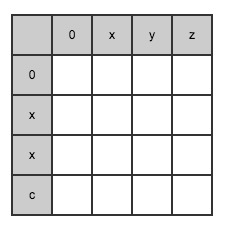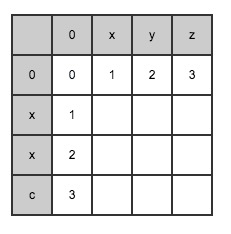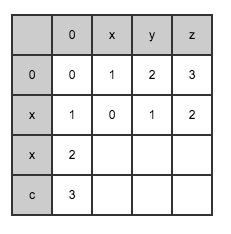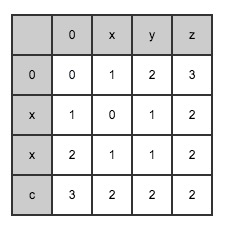summary
The Minimum Edit Distance (MED) was proposed by Vladimir Levenshtein, a Russian scientist, in 1965, hence the name Levenshtein Distance.
Levenshtein Distance is an index used to measure the similarity of two sequences in the fields of information theory, linguistics and computer science. Generally speaking, editing distance refers to two words Between, by one of the words
Between, by one of the words Convert to another word
Convert to another word The minimum number of single character editing operations required.
The minimum number of single character editing operations required.
There are only three single character editing operations defined here:
- Insertion
- Delete (Deletion)
- Substitution
For example, the minimum single character editing operations required to convert the words "kitten" and "siting" from "kitten" to "siting" are:
1.kitten → sitten (substitution of "s" for "k")
2.sitten → sittin (substitution of "i" for "e")
3.sittin → sitting (insertion of "g" at the end)
Therefore, the editing distance between the words "kitten" and "sitting" is 3.
Formal definition
We will use two strings  The Levenshtein Distance of is expressed as
The Levenshtein Distance of is expressed as  , where
, where and
and  Respectively corresponding
Respectively corresponding The length of the. So, here are two strings
The length of the. So, here are two strings  Levenshtein Distance, i.e
Levenshtein Distance, i.e  It can be described in the following mathematical language:
It can be described in the following mathematical language:

-
definition
-
 refer to
refer to  Middle front
Middle front  Characters and
Characters and  Middle front
Middle front  The distance between characters. For ease of understanding, here
The distance between characters. For ease of understanding, here Can be seen as
Can be seen as The length of the. The first character index of the string here starts from 1 (in fact, 0 needs to be filled in front of the string when calculating on the table), so the final editing distance is
The length of the. The first character index of the string here starts from 1 (in fact, 0 needs to be filled in front of the string when calculating on the table), so the final editing distance is  Distance at:
Distance at: 
-
When
 Corresponding to the string
Corresponding to the string Middle front
Middle front  Characters and strings
Characters and strings Middle front
Middle front  Characters, at this time
Characters, at this time  A value of 0 indicates that one of the strings a and b is an empty string, so the conversion from a to b only needs to be performed
A value of 0 indicates that one of the strings a and b is an empty string, so the conversion from a to b only needs to be performed One single character editing operation is enough, so the editing distance between them is
One single character editing operation is enough, so the editing distance between them is  , i.e
, i.e  The largest of.
The largest of. -
When
 When I was young,
When I was young, Is the minimum of the following three cases:
Is the minimum of the following three cases:
1. Indicates deletion
Indicates deletion 
2. Indicates insertion
Indicates insertion 
3. Represents substitution
Represents substitution 
-
 Is an indicator function that indicates when
Is an indicator function that indicates when  Take 0 when; When
Take 0 when; When  When, its value is 1.
When, its value is 1.
Process example
with  and
and  As an example, establish a matrix and record the calculated distance through the matrix:
As an example, establish a matrix and record the calculated distance through the matrix:

When When,
When, , initialize the first row and first column of the matrix according to this:
, initialize the first row and first column of the matrix according to this:
First line( index = 0)initialization:
min(0, 0) = 0 -> lev_{a, b}(0, 0) = max(0, 0) = 0
min(0, 1) = 0 -> lev_{a, b}(0, 1) = max(0, 1) = 1
min(0, 2) = 0 -> lev_{a, b}(0, 2) = max(0, 2) = 2
min(0, 3) = 0 -> lev_{a, b}(0, 3) = max(0, 3) = 3
First column( index = 0)initialization:
min(0, 0) = 0 -> lev_{a, b}(0, 0) = max(0, 0) = 0
min(1, 0) = 0 -> lev_{a, b}(1, 0) = max(1, 0) = 1
min(2, 0) = 0 -> lev_{a, b}(2, 0) = max(2, 0) = 2
min(3, 0) = 0 -> lev_{a, b}(3, 0) = max(3, 0) = 3

You can continue to derive the second line according to the above formula:
The second line (index = 1) is derived

Continue the iteration and deduce in the third line (index = 2)

Until the final result is derived:

Algorithm implementation
1 recursive method
def Levenshtein_Distance_Recursive(str1, str2):
if len(str1) == 0:
return len(str2)
elif len(str2) == 0:
return len(str1)
elif str1 == str2:
return 0
if str1[len(str1)-1] == str2[len(str2)-1]:
d = 0
else:
d = 1
return min(Levenshtein_Distance_Recursive(str1, str2[:-1]) + 1,
Levenshtein_Distance_Recursive(str1[:-1], str2) + 1,
Levenshtein_Distance_Recursive(str1[:-1], str2[:-1]) + d)
print(Levenshtein_Distance_Recursive("abc", "bd"))
>>>
2
2 dynamic programming
Recursion is decomposed from the back to the front. The opposite is to calculate from the front to the back and gradually deduce the final result. This method is called dynamic programming. Dynamic programming is very suitable for problems with overlapping computing nature, but a large number of intermediate computing results will be stored in this process. A good dynamic programming algorithm will minimize the spatial complexity.
def Levenshtein_Distance(str1, str2):
"""
Calculation string str1 and str2 Edit distance
:param str1
:param str2
:return:
"""
matrix = [[ i + j for j in range(len(str2) + 1)] for i in range(len(str1) + 1)]
for i in range(1, len(str1)+1):
for j in range(1, len(str2)+1):
if(str1[i-1] == str2[j-1]):
d = 0
else:
d = 1
matrix[i][j] = min(matrix[i-1][j]+1, matrix[i][j-1]+1, matrix[i-1][j-1]+d)
return matrix[len(str1)][len(str2)]
print(Levenshtein_Distance("abc", "bd"))
>>>
2
Application and thinking
Editing distance is a basic NLP algorithm to measure text similarity. It can be used as one of the important features of text similarity tasks. It can be applied to many aspects, such as spell checking, paper duplication checking, gene sequence analysis and so on. However, its disadvantages are also obvious. The algorithm is calculated based on the text's own structure, and there is no way to obtain the semantic information.
Because the matrix needs to be used, the space complexity is O(MN). This can achieve good performance when the two strings are relatively short. However, if the string is relatively long, it needs a lot of space to store the matrix. For example, if the two strings are 20000 characters, the size of the LD matrix is 20000 * 20000 * 2=800000000 Byte=800MB.
reference
[1] https://blog.csdn.net/ghsau/article/details/78903076
[2] https://en.wikipedia.org/wiki/Levenshtein_distance
[3] https://www.dreamxu.com/books/dsa/dp/edit-distance.html
[4] String similarity (edit distance algorithm) - simple book